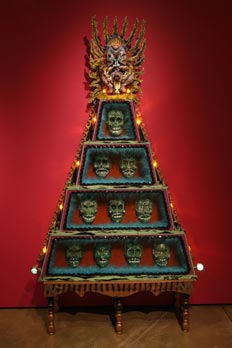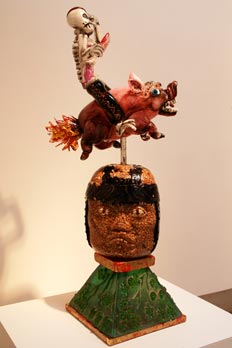Tamil Tiger When nine-months pregnant M.I.A. performed at the Grammy Awards a few weeks ago, it seemed a real possibility that she could have her baby on stage while Jay-Z, Kanye West, T.I. and Lil Wayne danced around the afterbirth. And while the big-bellied Sri Lankan/British artist sang vocals on “Swagga Like Us,” with a riff from her 2008 hit “Paper Planes,” it felt like it could happen. I wanted it to happen. The friend who gave my wife a copy of M.I.A.’s 2005 Arular called the album the next big thing; everyone was talking about it. At first listen, what clawed through the synth arrangements was the mix of world music and retro beats and a lyrical sense that fell somewhere between teen angst and child soldier. It’s like her words were flowing straight out of the sexiest, danciest war zone ever. La Frontera I finally got to see Meso-Americhanics (Maneuvering Mestizaje) de la Torre Brothers and Border Baroque, on display at the National Hispanic Cultural Center since September. The show, which has been extended through the middle of August, features the mixed media works of brothers Jamex and Einar de la Torre. Dividing their time between Ensenada, Mexico, and San Diego, Calif., the brothers construct some seriously crazy sculptures that mix their Mexican and American influences. There is a questioning that takes place in the blurring of the two nations’ disparate iconographies and materials, one that simultaneously challenges and confirms issues of exoticism and power. One example would be the installation Colonial Atmosphere , where there is a massive Olmec head “as a lunar module accompanied by the goddess Coatlique in the form of an astronaut” planting a cut steel and chain flag into the floor of the cratered moon. Low-rider culture and imperialism, bad television and Pre-Columbian power blur, giving off the strangest vibe. But the impulse to thrust the brothers’ work into a discussion about high and low art is quashed by their ability to move all of their materials in the direction of their ideas. Soda cans, fur and commemorative coins are made to serve the artists’ conceptual goals, moving beyond their initial power of souvenirs or simple cultural detritus. They choose popular subjects—religion and wrestling come to mind—but they bend those subjects over a type of black humor anvil that gives Christ a headband that says “Taco Time” while he hangs crucified to a saguaro. The empathy asked of the viewer is allotted to both Jesus and every man, woman and child risking his or her life to work in the United States. The humor shields the directness of those statements, though, and the brothers are able to engage on multiple levels (craft, politics, history, comics, border issues). What you come across in “Baja Kali” or the beaner portraits (the artists’ description of portraits made from beans) is both lovely and threatening. The clang of their kinetic “La Belle Epoch” falls on your ears before you actually see it, the Ferris wheel-like disks paralleling the movement of an Aztec calendar or the inside of a Swiss watch made out of beer cans and knives. And maybe I’m biased, but I think it’s impossible not to be bowled over with work that includes blown glass, luchadores, a giant blonde Jesus, bloody fangs, hubcaps, videos, skulls, fur, silver rattlesnakes in car tires, guitars, lunar landers and a super-large Olmec head. Anthropology Wall text seems necessary to institutions that want things to be accessible and understood. For Meso-Americhanics , there is wall text everywhere—which is my main beef with the show—primarily to explain the history, chronology and processes of the de la Torre brothers’ works. While on the one hand I get the need to explicate, there came a point in this exhibition when I felt hemmed in. The experience was so mapped out and prescribed that it became a little unclear if I would be tested over the history lesson in front of me or even allowed the freedom to engage the work on my own terms. I realize that’s the line an institution like NHCC needs to walk, but it dampened some of the freshness I felt in the brothers’ sculptures and wall pieces. In my experience, people don’t learn through those kinds of educational additives. They get turned off. Lanugo The difficulty in making anything steeped in historical relevance comes in getting people who don’t share that history to care about it. When you read that M.I.A.’s father was a member of the revolutionary group Tamil Tigers in Sri Lanka and that her family was on the run for years, it adds to what you think you hear in both Arular and her 2007 release Kala . But the question arises of how to navigate between her life story and her hit-making appeal. Where do you put the gravity of a civil war that has lasted more than 30 years? Is it a choice between passion and dispassion, or is it just music? The mixtures in her music and in the de la Torre brothers’ art should be expected in a world where everyone’s trying to hold onto the family tree whose roots stretch around the globe.











